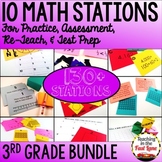Composing and Decomposing Numbers Stations
- PDF
Also included in
- Are you looking for math stations that will take you through the whole school year? This set of 3rd grade math centers has 130 different math games aligned to thirteen different standards. These low-prep math stations will keep your students engaged and learning in authentic ways all year long! MathPrice $89.95Original Price $130.00Save $40.05
Description
This set of 10 math stations all focus on the 3rd grade standards for composing and decomposing numbers. With 10 different centers to practice with your students will be experts in no time flat while playing these partner math games.
Check out the 3rd Grade Math Test Prep Bundle
This composing and decomposing numbers test prep bundle is a no frills all action product meant to cement students' knowledge of composing and decomposing numbers for standardized testing. All ten of the activities included were created entirely in black and white to save on colored ink, and make for easy use of the copy machine.
I use these activities in class and with my testing study group after school.
++++++++++++++++++++++++++++++++++++++++++++++++++++
It was created with the following standards in mind:
TEKS-3.2(A) compose and decompose numbers up to 100,000 as a sum of so many ten thousands, so many thousands, so many hundreds, so many tens and so many ones using objects, pictorial models, and numbers, including expanded notation as appropriate
Common Core
CCSS.MATH.CONTENT.2.NBT.A.1 Understand that the three digits of a three-digit number represent amounts of hundreds, tens, and ones; e.g., 706 equals 7 hundreds, 0 tens, and 6 ones. Understand the following special cases.
CCSS.MATH.CONTENT.2.NBT.A.1.A 100 can be thought of as a bundle of ten tens-called a “hundred”
CCSS.MATH.CONTENT.2.NBT.A.1.B The numbers 100, 200, 300, 400, 500, 600, 700, 800, 900 refer to one, two, three, four, five, six, seven, eight, or nine hundreds (and 0 tens and 0 ones).
++++++++++++++++++++++++++++++++++++++++++++++++++++
All of the activities included are designed to be used to fill in any gaps that students may have understanding how to compose or decompose numbers.
Each activity can be completed in a variety of settings to meet the needs of every learner in your classroom.
-Independent assessment
-Partner practice
-Small group guided math
++++++++++++++++++++++++++++++++++++++++++++++++++++
Also included in this product:
Answer keys when appropriate
Recording sheets to hold students accountable
Content vocabulary for your word wall
Test bridge questions
Other 3rd Grade Big Ten Resources:
Composing and Decomposing Numbers
Comparing and Ordering Numbers
Addition and Subtraction Models within 1,000
Multiplication and Division Models within 100
Paired Number Tables and Patterns
+++++++++++++++++++++++++++++++++++++++++++++++++++++
For more test prep check out my Test Smash series:






